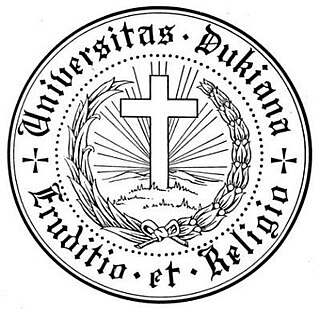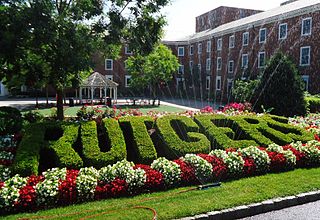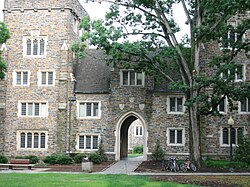
Duke University is a private research university in Durham, North Carolina, United States. Founded by Methodists and Quakers in the present-day city of Trinity in 1838, the school moved to Durham in 1892. In 1924, tobacco and electric power industrialist James Buchanan Duke established The Duke Endowment and the institution changed its name to honor his deceased father, Washington Duke.

California State University, San Marcos is a public university in San Marcos, California. It was founded in 1989 as the 21st campus in the California State University (CSU) system.

Richard Halleck Brodhead is an American scholar of 19th-century American literature. He is a former dean of Yale College, and served as the 9th president of Duke University in North Carolina, from 2004 to 2017.
The main campus of Virginia Tech is located in Blacksburg, Virginia; the central campus is roughly bordered by Prices Fork Road to the northwest, Plantation Road to the west, Main Street to the east, and U.S. Route 460 bypass to the south, although it also has several thousand acres beyond the central campus. The Virginia Tech campus consists of 130 buildings on approximately 2,600 acres (11 km2). It was the site of the Draper's Meadow massacre in 1755 during the French and Indian War.
The history of Duke University began when Brown's Schoolhouse, a private subscription school in Randolph County, North Carolina, was founded in 1838. The school was renamed to Union Institute Academy in 1841, Normal College in 1851, and to Trinity College in 1859. Finally moving to Durham in 1892, the school grew rapidly, primarily due to the generosity of Washington Duke and Julian S. Carr, powerful and respected Methodists who had grown wealthy through the tobacco industry. In 1924, Washington Duke's son, James B. Duke, established The Duke Endowment, a $40 million trust fund, some of which was to go to Trinity College. The president thus renamed the school Duke University, as a memorial to Washington Duke and his family.

At the Massachusetts Institute of Technology (MIT), students are housed in eleven undergraduate dorms and nine graduate dorms. All undergraduate students are required to live in an MIT residence during their first year of study. Undergraduate dorms are usually divided into suites or floors, and usually have Graduate Resident Assistants (GRA), graduate students living among the undergraduates who help support student morale and social activities. Many MIT undergraduate dorms are known for their distinctive student cultures and traditions.

John Carlisle Kilgo served as a bishop in the Methodist Episcopal Church, South (MECS) from 1910 to 1922. From 1894 to 1910, Kilgo was the president of Trinity College, in Durham, North Carolina, the predecessor of Duke University. Earlier, Kilgo was a circuit preacher in South Carolina and a financial agent of Wofford College.

Housing at the University of Chicago includes seven residence halls that are divided into 48 houses. Each house has an average of 70 students. Freshmen and sophomores must live on-campus. Limited on-campus housing is available to juniors and seniors. The university operates 28 apartment buildings near campus for graduate students.

Housing at Georgetown University consists of 13 residence halls at the main campus and a law center campus. Housing on Georgetown's main campus is divided between "halls," usually more traditional dormitories, and "villages", usually less traditional apartment complexes. In addition, Georgetown operates many townhouses in the Georgetown neighborhood, usually for second, third, and fourth-year students.
Housing at the University of Georgia is managed by the Department of University Housing. On campus housing for undergraduate students is divided into ten communities, and for graduate students into three communities.
College Houses are a major part of facilitating a community and experience amongst the undergraduates at the University of Pennsylvania. Each house has one Faculty Director and one House Director, with at least two College House Fellows in residence. Many houses host a range of jobs for students, including Residential Advisors, House Councils, Managers and Information Technology assistants. The houses also encourage communities through the wide range of Program Communities within the system.
Since the founding, Stanford University has provided on-campus housing for students. Today, all undergraduate students, most graduate students, and many graduate employees use campus housing. While not all graduate students are eligible for campus or subsidized off-campus housing, of those that are, only 64% are able to take advantage of this opportunity due to the limited housing stock. Student Housing at Stanford is currently part of Residential & Dining Enterprises, an in-house standalone vendor within the Stanford affiliated network of businesses.

Fifteen percent of University of Houston students live on campus. UH has several on campus dormitories: Moody Towers, The Quads, Cougar Village I, Cougar Village II, Cougar Place, and University Lofts. UH also has partnerships with three private complexes, Bayou Oaks, Cullen Oaks, and Cambridge Oaks.

The main campus of the Georgia Institute of Technology occupies part of Midtown Atlanta, primarily bordered by 10th Street to the north, North Avenue to the south, and, with the exception of Tech Square, the Downtown Connector to the East, placing it well in sight of the Atlanta skyline. In 1996, the campus was the site of the athletes' village and a venue for a number of athletic events for the 1996 Summer Olympics. The construction of the Olympic Village, along with subsequent gentrification of the surrounding areas, significantly changed the campus.

College Avenue is the oldest campus of Rutgers University – New Brunswick, in New Brunswick, New Jersey, U.S. It includes the historic seat of the university, known as Old Queens and the campus of the New Brunswick Theological Seminary. Many classes are taught in the Voorhees Mall area, also home to the Zimmerli Art Museum. It is within walking distance of the train, shops, restaurants, and theaters in downtown New Brunswick and is served by Rutgers Campus Buses, a zero-fare bus network.

East Campus is part of Duke University's campus in Durham, North Carolina. East Campus, along with West Campus, make up most of Duke's main campus. The campus follows the Georgian architecture style, making it distinct from West Campus. Currently, East Campus is the exclusive residential home to first-year students. It borders Trinity Historic District to the east and Walltown Neighborhood to the north.

The J. Deryl Hart House is the official residence for the President of Duke University in Durham, North Carolina. Built between 1933 and 1934 for Julian Deryl Hart, the three-story brick and timber Tudor Revival mansion is located on the university's West Campus, near Wallace Wade Stadium, at the crossroads of Duke University Road and Academy Road.

The Douglas M. and Grace Knight House, also known as Knight House, is a Modernist-style mansion in Durham, North Carolina. The house, designed by Alden B. Dow, previously served as the official residence for presidents of Duke University and is now used by the university as an event space, conference facility, and guest house. On April 6, 1968, following the assassination of Martin Luther King Jr., four-hundred and fifty university students marched to the house during the Silent Vigil at Duke University to deliver a list of demands to Duke president Douglas M. Knight. The house, previously called University House, was officially named after Knight and his wife, Grace Nicholas Knight, in 2003.

















